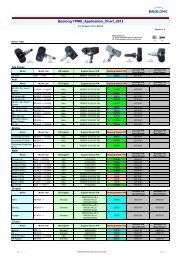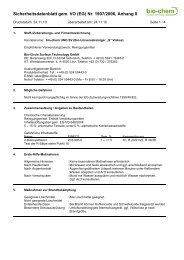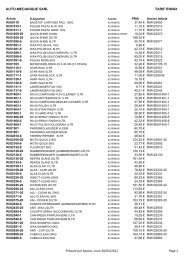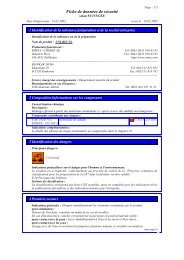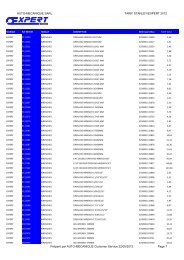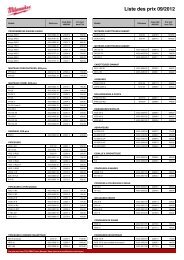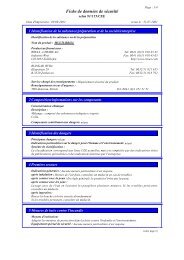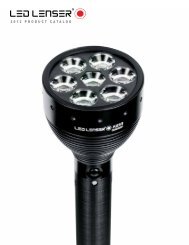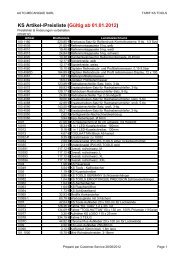REPAIR & SUPPLIES - Auto-Mecanique
REPAIR & SUPPLIES - Auto-Mecanique
REPAIR & SUPPLIES - Auto-Mecanique
Create successful ePaper yourself
Turn your PDF publications into a flip-book with our unique Google optimized e-Paper software.
Glossary of TPMS terms<br />
ABS – Anti-lock braking system.<br />
Activation Tool – Electronic tool used to activate,<br />
trigger or wake-up a TPMS sensor once it has entered<br />
the Sleep Mode. Typically, the tool sends a 125kHz LF<br />
signal to the TPMS sensor forcing it to wake-up and<br />
transmit data. Activation tools may be needed to aid<br />
in the relearn processes.<br />
Banded Sensor – Sensor mounted in the drop<br />
center of the wheel using a metal band. The sensor<br />
is typically mounted 180° from the valve stem. The<br />
sensor is attached to the metal band using a cradle<br />
and secured to the cradle with a plastic clip. Ford is<br />
the only vehicle manufacturer that uses banded<br />
sensors, as original equipment, on their vehicles.<br />
Clamp-in Style Sensor – Sensor mounted to the<br />
wheel through the rim hole using a special sealing nut<br />
to secure it into the wheel. These sensors can usually<br />
be identified by their aluminum valve stem.<br />
Cradle – The carrier that holds the banded sensor<br />
to the band.<br />
Continuous Wave Sensors – Sensors designed to<br />
trigger when they are exposed to a continuous<br />
electronic signal for 4-7 seconds.<br />
Direct TPMS – System that uses wheel mounted<br />
sensors or transmitters to transmit information to<br />
the vehicles ECU. This system meets current<br />
federal regulations.<br />
Drive Mode – When a vehicle reaches a certain<br />
velocity, for a specified period, the sensor enters<br />
drive mode and transmits data at regular intervals.<br />
ECU – Electronic Control Unit.<br />
FCC – Federal Communications Commission<br />
FMVSS 138 – The Federal Motor Vehicle Safety<br />
Standard adopted by the NHTSA, as required by<br />
legislation known as the TREAD Act, mandating<br />
that TPMS be installed on all new vehicles having<br />
a GVWR of 10.000 lbs. or less except motorcycles<br />
and those vehicles with dual wheels on an axle.<br />
Gross Vehicle Weight (GVW) – The total weight of<br />
a loaded vehicle including the chassis, body<br />
and payload.<br />
ID – Identification<br />
Indirect TPMS – System based on the use of a<br />
vehicles ABS. This type of system does not require<br />
the use of sensors or transmitters. Indirect systems<br />
were once popular, but those systems did not meet<br />
current federal regulations.<br />
Learn Mode – Mode in which the vehicles receiver<br />
stores the sensors ID, within its memory, for future<br />
identification purposes.<br />
LF – Low Frequency (Trigger Frequency) 125kHz<br />
Magnetically Triggered Sensors – Sensor designed<br />
to trigger when exposed to a powerful magnetic wave<br />
NHTSA – National Highway Traffic Safety<br />
Administration. The U.S. federal agency that<br />
develops and administers educational, engineering<br />
and enforcement programs for safe vehicle use<br />
and cost-effective highway travel.<br />
Normal Mode – Also referred to a Park Mode, is the<br />
state the TPMS sensor is in during normal driving<br />
operations.<br />
OBDII – On-Board Diagnostic systems were<br />
introduced as an electronic means to control engine<br />
functions and diagnose engine problems. OBDII,<br />
introduced in the mid-90’s, provides almost complete<br />
engine control and also monitors parts of the chassis,<br />
body and accessory devices, as well as the diagnostic<br />
control network of the car.<br />
OEM – Original Equipment Manufacturer.<br />
Off Mode – Also referred to as Ship Mode is the<br />
TPMS sensor state where no transmission occurs and<br />
pressure sampling occurs once every 30 seconds.<br />
Mainly used for shipment and storage, sensors will<br />
remain in this condition until activated into another<br />
mode. Sensors being shipped from overseas are often<br />
shipped in Off Mode because the FCC will not allow<br />
any electronic devices to transmit any type of signal<br />
that may interfere with radio air waves. It is important<br />
to note that not all sensors are shipped in this mode.<br />
Park Mode – Also referred to as Normal Mode, is<br />
the state the TPMS sensor is in during normal driving<br />
operations.<br />
Pulse Modulated Sensors – Sensors designed to<br />
trigger when they are exposed to a 125kHz signal<br />
with a specific and exclusive OEM electronic pattern.<br />
Protocol – The specific internal programming that<br />
runs the TPMS sensor.<br />
Receiver – Device that decodes the TPMS sensor<br />
data and converts it into information used by the<br />
vehicles onboard computer system.<br />
116



